
Local transport: The freight profile of a Cathedral City
MDS Transmodal (MDST) carried out a commercial vehicle traffic survey in November 2023 as part of a programme of work to develop a freight strategy for Chester city centre. It follows from the survey of businesses which investigated the perception of businesses regarding the delivery and collection of freight in the city centre, much of which has been pedestrianised with a time window for access by vehicles in the morning and evening. This survey of the morning peak for deliveries between 07.00 and 11.00 in the heritage city centre showed that 76% of vehicles were light goods vehicles, 18% were (generally small) HGVs, 6% were waste collection vehicles and 1% were bicycles being used for food deliveries. Just under 3% of all movements were by zero emission vehicles (including bicycles).
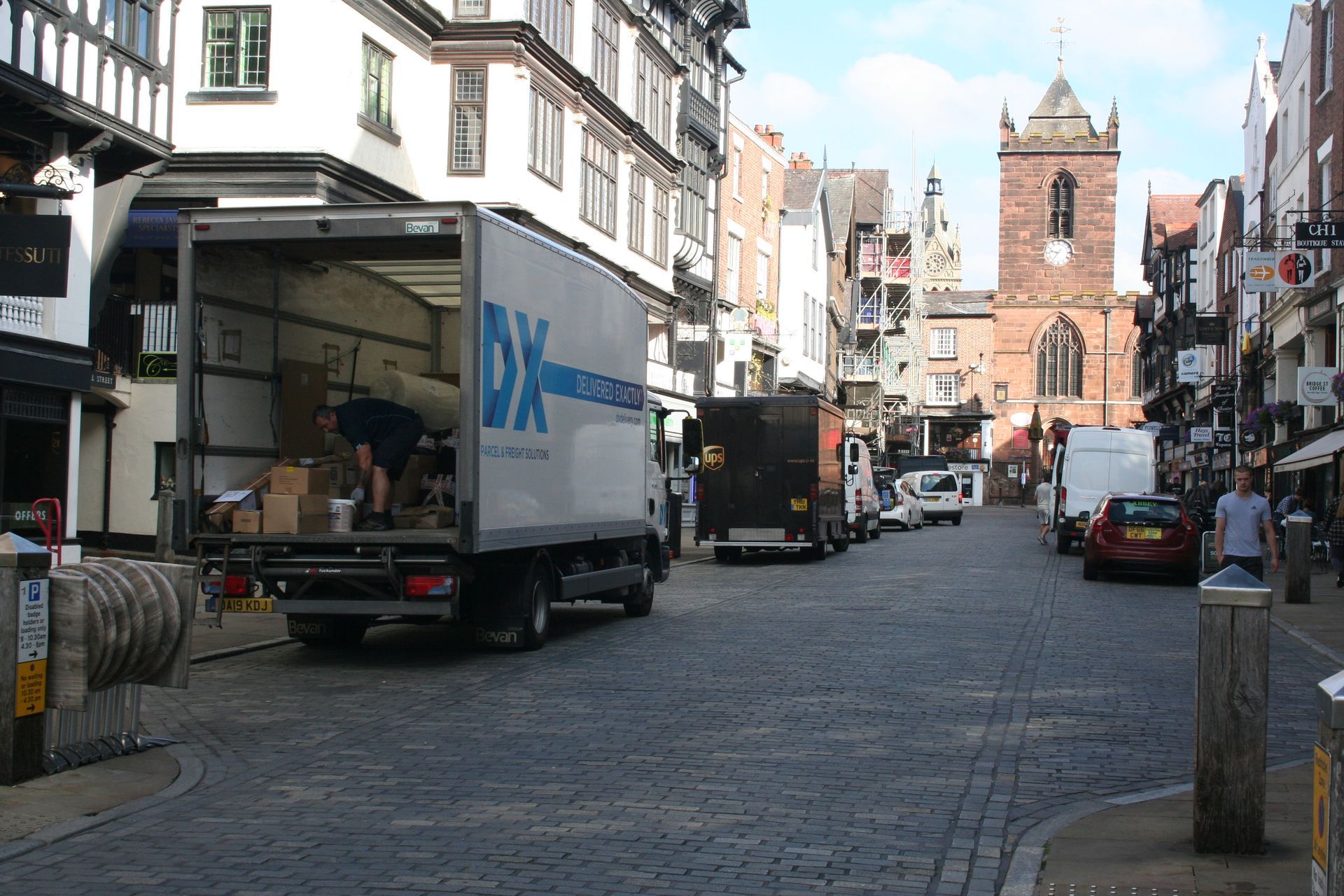
Chester is a
historic heritage city in Cheshire in North West England. Founded as a Roman fortress in AD75, it
contains a number of historic sites including the most complete city walls in
Britain, a thousand-year old Cathedral, shops on two levels called the Rows which
were originally built in the Middle Ages and distinctive Tudor-style black and
white buildings. Its centre serves as a
destination for tourism supported by businesses in the leisure and hospitality
industry, and a retail sector focused on small specialist shops and outlets
with an e-commerce offering as well as larger retail chains. As such, businesses
require often small-volume, but frequent goods deliveries. This generates high
trip rates into urban areas by both lights goods vehicles (LGVs) and smaller heavy
goods vehicles (HGVs).
To protect its heritage characteristics and the safety of pedestrians, the historic city centre has restricted access to vehicles from 10:30am to 4:30pm. As a result, most deliveries are carried out in the morning peak delivery period before 10:30am. The map below shows the area enclosed by a red line where vehicles’ movements are time-limited.
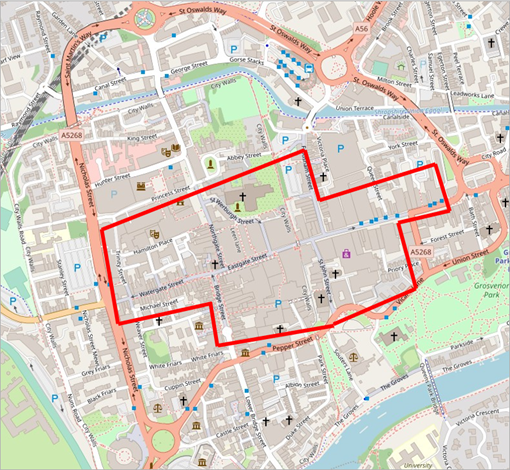
During the Covid-19 pandemic, pedestrianisation hours were extended from 4.30pm to 8.00pm in order to support hospitality venues, specifically those offering outdoor Alfresco drinking and dining. After implementing the extension for two years, a proposal was put forward seeking views on making the pedestrianisation extension a permanent arrangement. Feedback indicated that the majority of residents favour pedestrianisation for its safety and environmental benefits. The main concern it presents is its impact on businesses’ delivery arrangements.
In this context, a traffic survey was carried out to quantify the number and type of commercial vehicle (LGVs, HGVs, waste collection vehicles, and bicycles used for deliveries) entering Chester city centre during the morning “peak” freight delivery period. Where possible, it additionally aimed to estimate their origin and purpose of visit based on the nature of the business advertised on the vehicle. Vehicle movements were recorded at rising bollards at four locations intended to capture the entry and exit of vehicles at the city centre access and egress points.
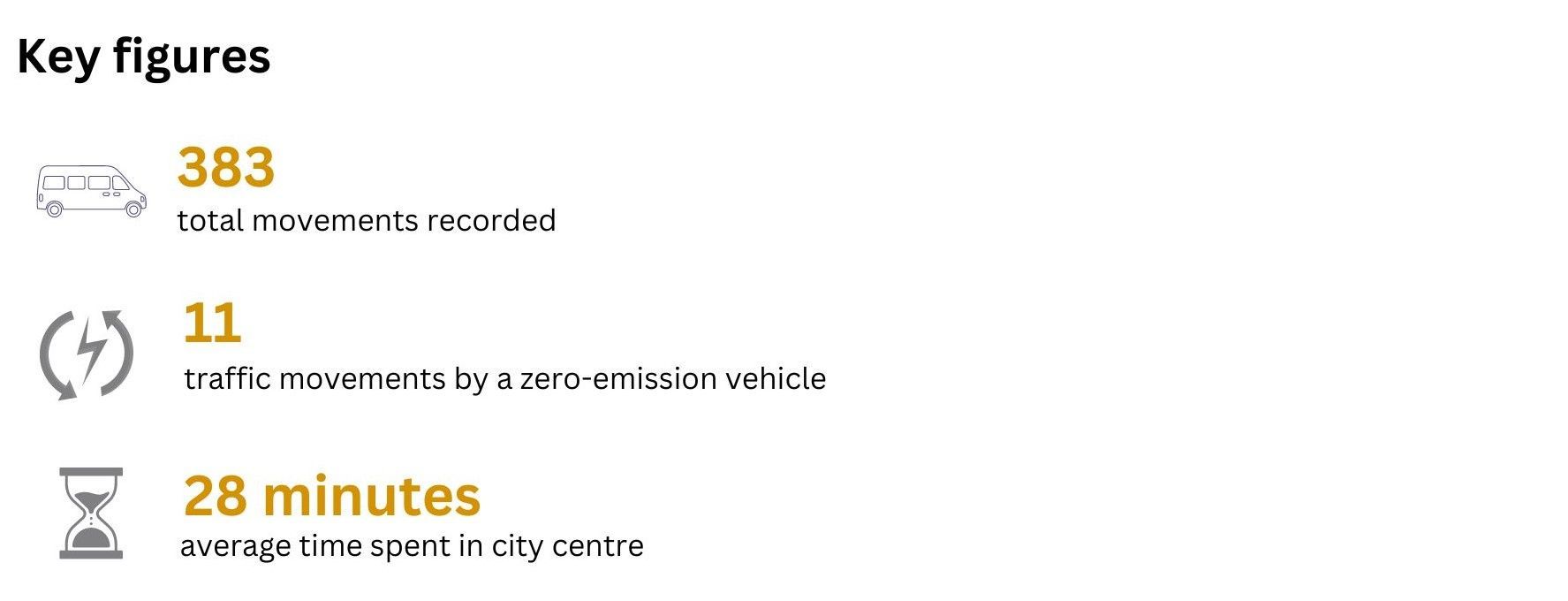

By location, 131 movements were recorded at the northernmost location on Northgate Street, which is where most commercial vehicle movements were noted. It is closely followed by St John Street, to the east of the city centre, where 114 vehicle movements, the equivalent of 30% of all movements, were recorded. Bridge Street and Watergate Street had a comparable number of movements, with 19% and 17% respectively. By direction therefore, movements in three out of the four locations (St John Street, Bridge Street and Watergate Street) were exclusively in one direction. The exception is the northernmost location on Northgate Street where the vast majority (86%) of vehicles were driving into the city centre and 14% were driving out.
This implies possible routes for commercial vehicles driving through the city centre, whereby they either enter through Northgate Street and exit through St John Street, or through Bridge Street to the south and exit from Watergate Street to the west. A closer examination of the data shows that each vehicle’s movements was not necessarily limited to a single entry and exit, with some vehicles making multiple entries and exits. This was particularly true for waste collection vehicles.
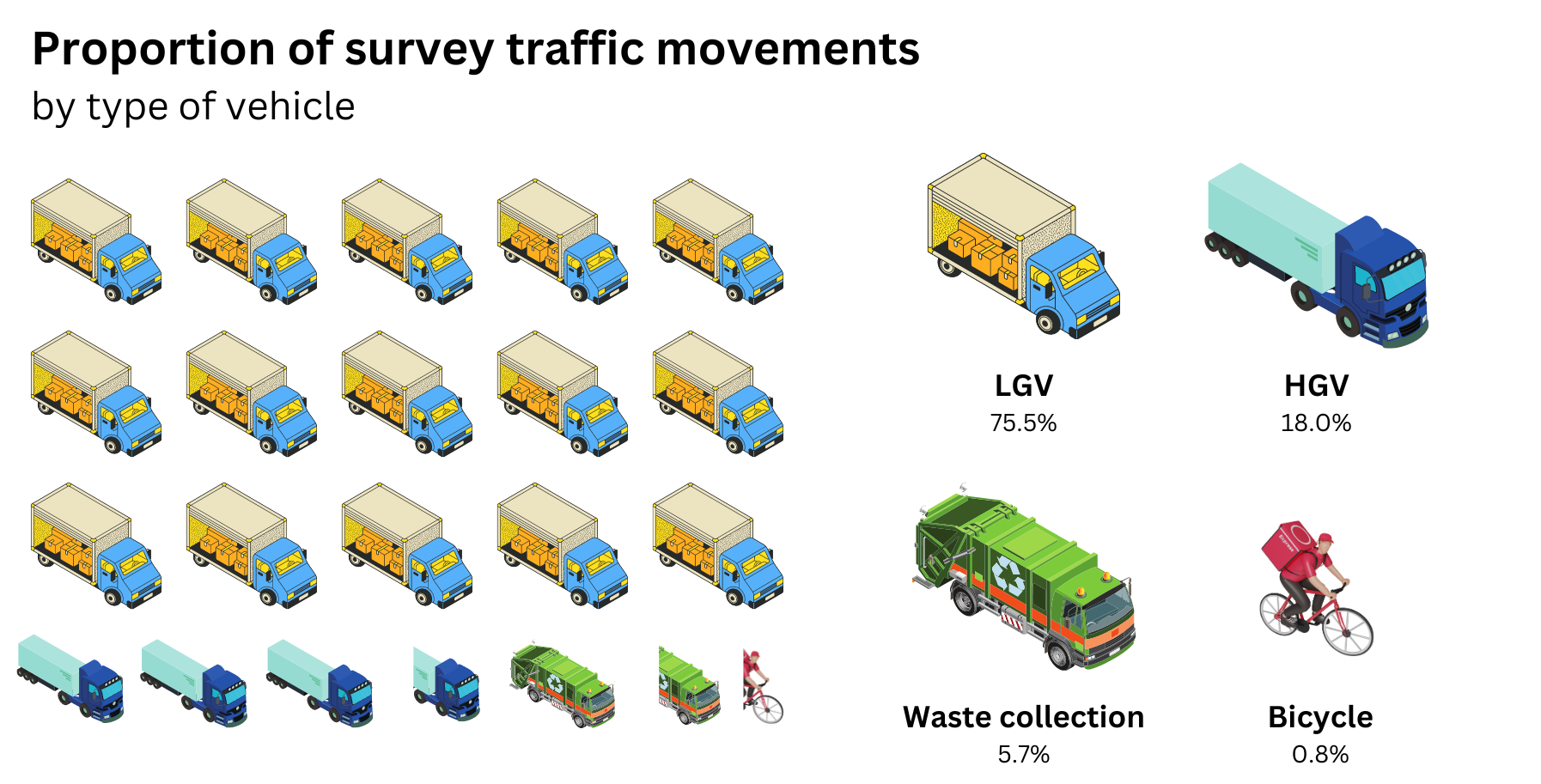
By vehicle type, most freight and servicing vehicles recorded were LGVs (75.5%) followed by HGVs (18.0%). Waste collection vehicles made up 5.7% while bicycles used for food takeaway deliveries recorded the smallest proportion (0.8%). This is reflective of the location, as LGVs and small HGVs are most suited for urban freight transport and servicing activities.
The chart below shows the breakdown of movements by time and direction. 44% of total freight and servicing traffic was focused in the hour between 09:30-10:30, which can be considered the peak for freight movements. From the start of the survey at 07:30 until 09:00, there were more vehicles entering than leaving the city centre. From 09:00 onwards, this trend is reversed as vehicles rush to conclude their business in the city centre before bollards are raised and access is restricted. Movements in both directions then diminished as the city centre was closed to traffic.
This is aligned with results from the survey of businesses, where 61% of businesses surveyed reported receiving deliveries between 09:00 and 10:30. However, the latter survey was not limited to businesses located within the pedestrianised zone, therefore the remaining respondents can receive deliveries during the rest of the morning or during the afternoon. As pedestrianisation is only applicable to motorised vehicles, “last mile” deliveries and collections can take place using other modes such as cargo bikes or on foot using handcarts. It could therefore encourage a degree of modal shift, however, results from the survey of businesses indicated limited use of bicycles or on-foot freight deliveries and collections.
Research on the impact of part-time pedestrianisation points to a change in behaviour of transport operators who have to adjust their deliveries within a shorter timeframe. This could mean operating a larger number of smaller vehicles if multiple time-restricted locations have to be served simultaneously. Similarly, concentrating deliveries during the peak commuting period could exacerbate congestion, leading to more time-consuming and relatively inefficient deliveries.
In this case, as the pedestrianised zone is quite small, freight transport operators may shift delivery schedules so that deliveries within the pedestrianised zone are prioritised in the morning before access is restricted, and then other locations are served by the same vehicles later in the day; this might allow the operators to maintain the same number of vehicles used and trips undertaken so that operational costs are not affected.
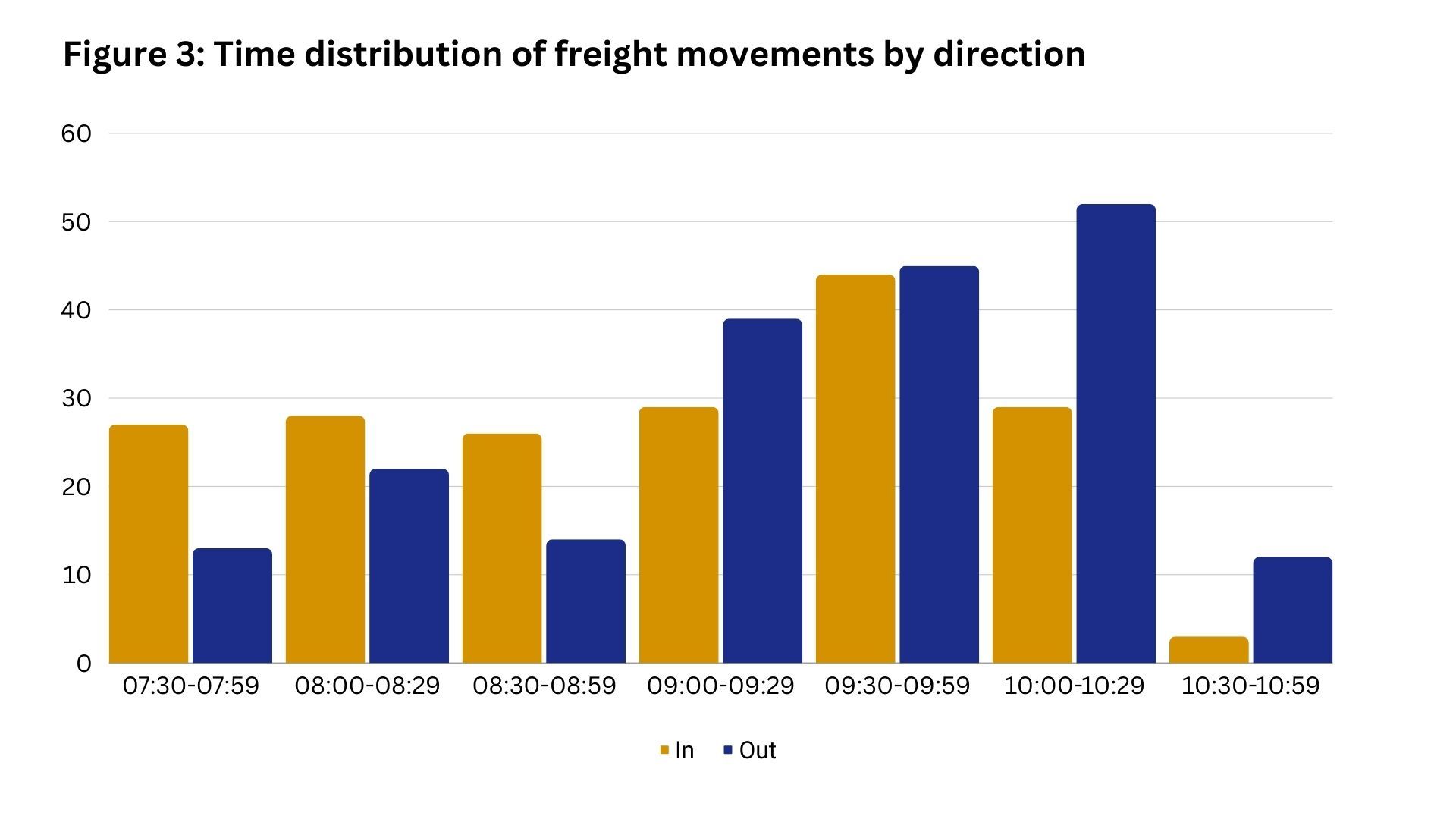
The general purpose of the trip was estimated using the company name as advertised on the vehicle and was assigned into one of four categories: freight; servicing; waste collection; or unknown. The latter category was attributed to unmarked vehicles. About 40%, or 155 movements, were clearly identified to be transporting freight and one-third of these movements were by (generally small) HGVs. A comparable proportion of movements (31%) did not have an explicitly identified purpose.
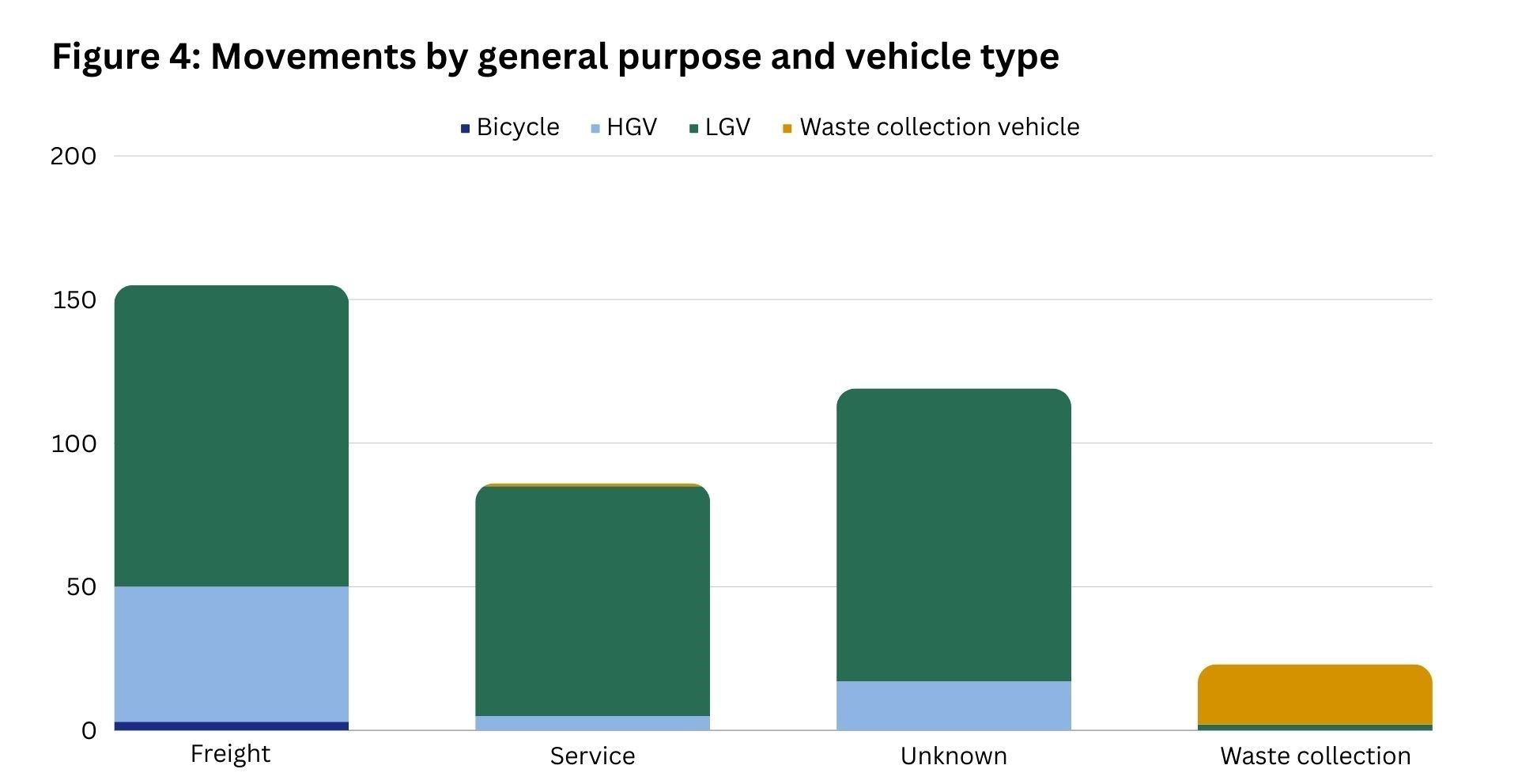
The histogram chart below shows the distribution of the amount of time spent in the city centre by vehicles identified at more than one location during the duration of the survey. The time between when a vehicle was first and last observed largely depends on the journey’s purpose. The most common journey duration was less than 15 minutes, which is in line with general loading and unloading regulations of a maximum of 20 minutes on loading bays. The short journey time could also be due to the small size of the area covered by pedestrianisation, as a single trip through the city centre could be covered in that time.
About a third of the vehicles – both freight and servicing vehicles - carrying out a single journey spent five minutes or less in the city centre, which suggests they were either making very quick deliveries/collections or driving through the city centre without stopping en route between locations outside the geographic area of the survey.
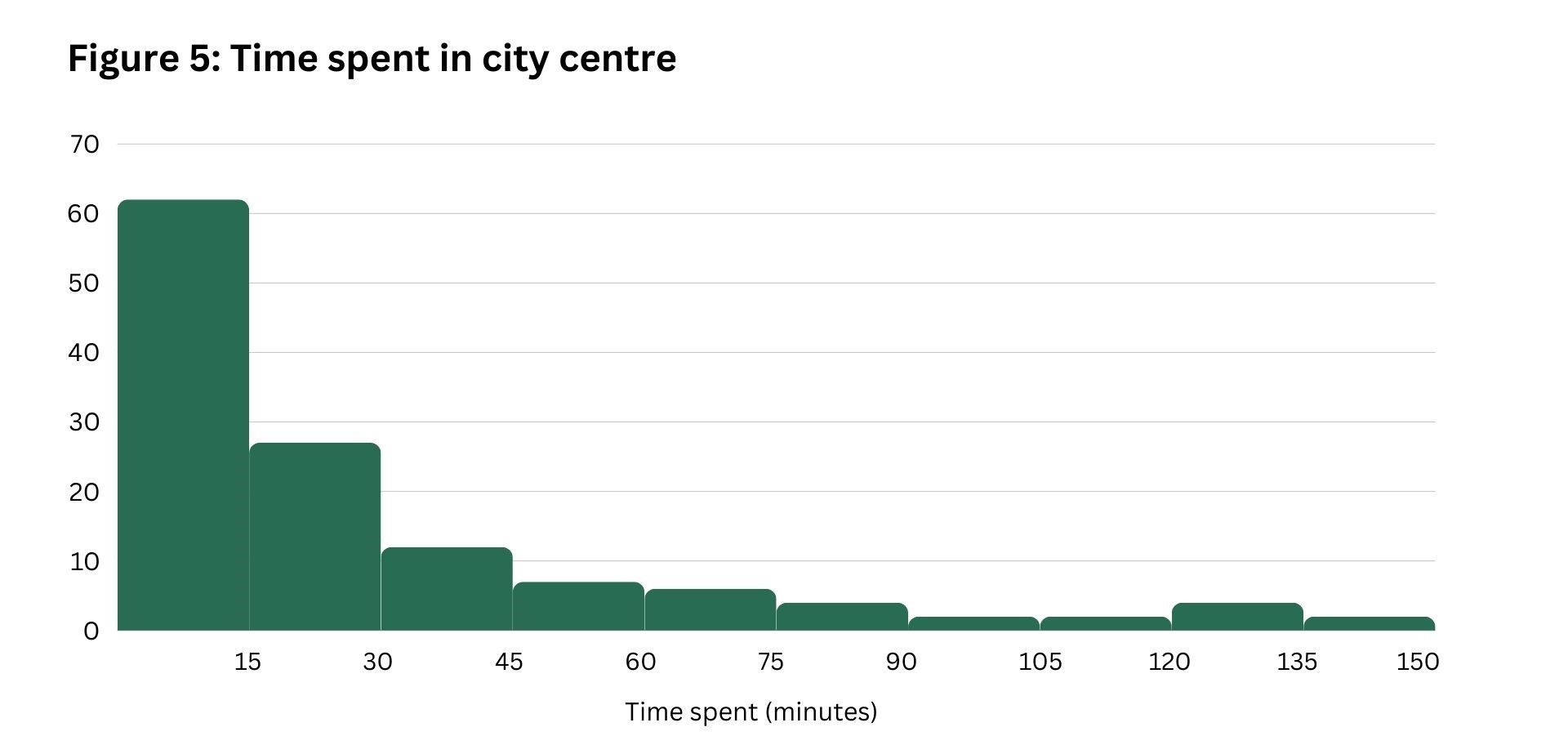
Results from this traffic survey supported the results from the MDST survey of businesses, which found that the ban on vehicles in the pedestrianised area during the day did not present major issues to businesses. This is because logistics providers and servicing businesses have adapted to the time windows and therefore plan their route so that deliveries or collections in the city centre take place during the appropriate time.
